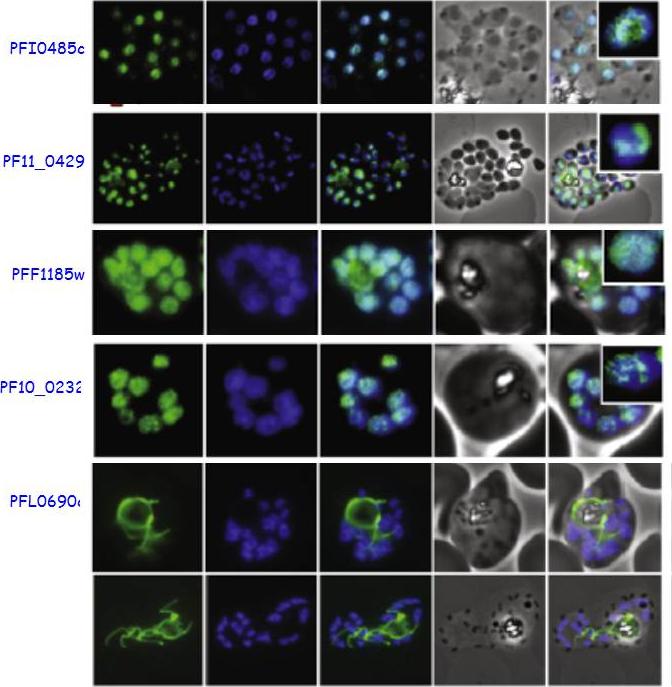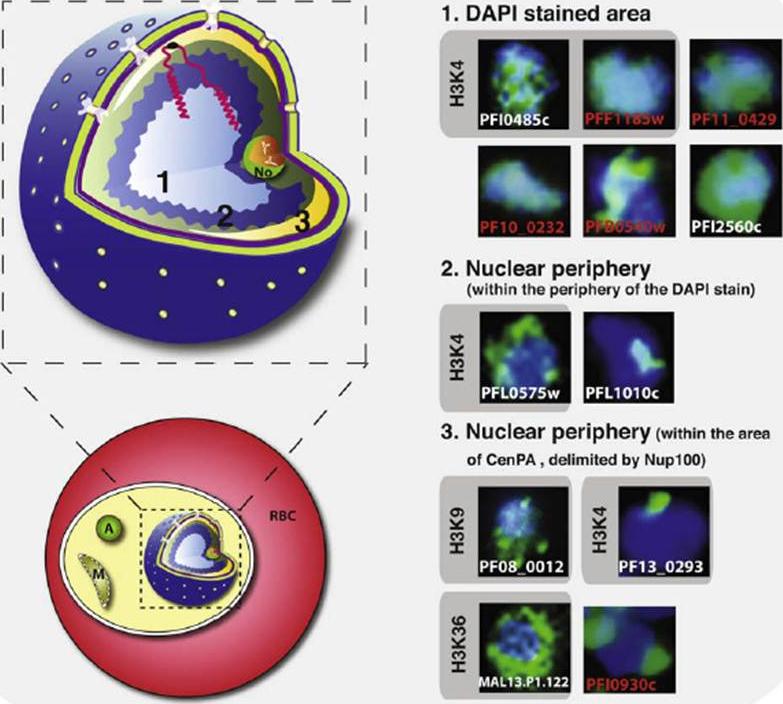PF3D7_1023900 chromodomain-helicase-DNA-binding protein 1 homolog, putative (CHD1)
Disruptability [+]
| Species | Disruptability | Reference | Submitter | |
|---|---|---|---|---|
| P. falciparum 3D7 |
Possible |
USF piggyBac screen (Insert. mut.) | USF PiggyBac Screen | |
| P. berghei ANKA |
Refractory |
RMgm-507 | Imported from RMgmDB | |
| P. berghei ANKA |
Refractory |
PlasmoGEM (Barseq) | PlasmoGEM | |
Mutant phenotypes [+]
None reported yet. Please press the '+' button above to add one.Imaging data (from Malaria Metabolic Pathways)

Live imaging of GFP-transgenic Plasmodium falciparum lines reveals the localization of 4 nuclear proteins, which localize to the central part of the nucleus stained by DAPI (blue panel) and the bottom one which localizes to the mitochondrion. Insets show one enlarged schizont nucleus.Volz J, Carvalho TG, Ralph SA, Gilson P, Thompson J, Tonkin CJ, Langer C, Crabb BS, Cowman AF. Potential epigenetic regulatory proteins localise to distinct nuclear sub-compartments in Plasmodium falciparum. Int J Parasitol. 2010 40(1):109-21. Copyright Elsevier
See original on MMP
Schematic representation of the Plasmodium falciparum nuclear architecture. A schematic representation of an infected red blood cell (RBC) and an enlargement of the P. falciparum nucleus are shown. From the centre towards the periphery we have defined three distinct areas (1–3) in which nuclear proteins specifically distribute. A summary is shown in which trophozoite stages have been analyzed. Proteins, previously predicted to functionally interact, are shown in red. Proteins previously predicted for their histone target sites are indicated by grey boxes. A, apicoplast. M, mitochondria, No, nucleolus.Volz J, Carvalho TG, Ralph SA, Gilson P, Thompson J, Tonkin CJ, Langer C, Crabb BS, Cowman AF. Potential epigenetic regulatory proteins localize to distinct nuclear sub-compartments in Plasmodium falciparum. Int J Parasitol. 2010 40(1):109-21. Copyright Elsevier.
See original on MMPMore information
| PlasmoDB | PF3D7_1023900 |
| GeneDB | PF3D7_1023900 |
| Malaria Metabolic Pathways | Localisation images Pathways mapped to |
| Previous ID(s) | PF10_0232 |
| Orthologs | PBANKA_0508100 , PCHAS_0508200 , PKNH_0608400 , PVP01_0609100 , PVX_111520 , PY17X_0509200 |
| Google Scholar | Search for all mentions of this gene |